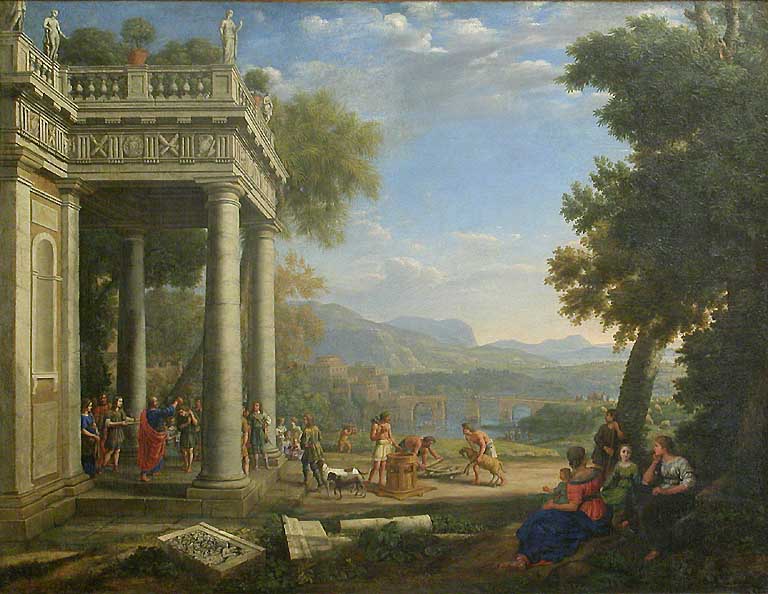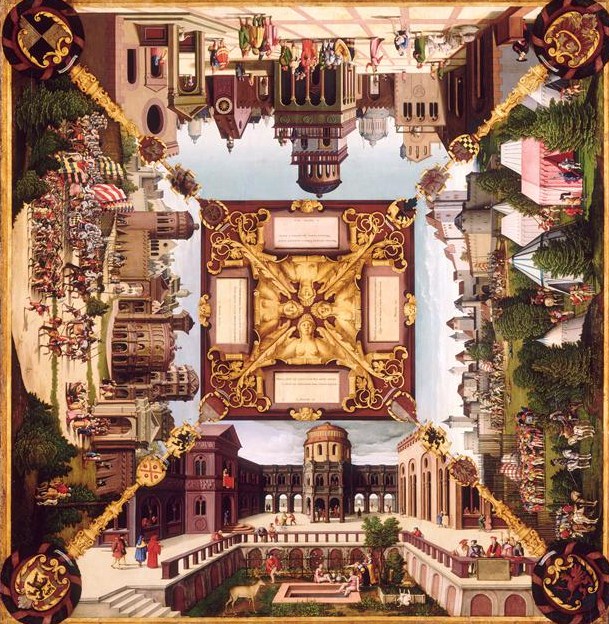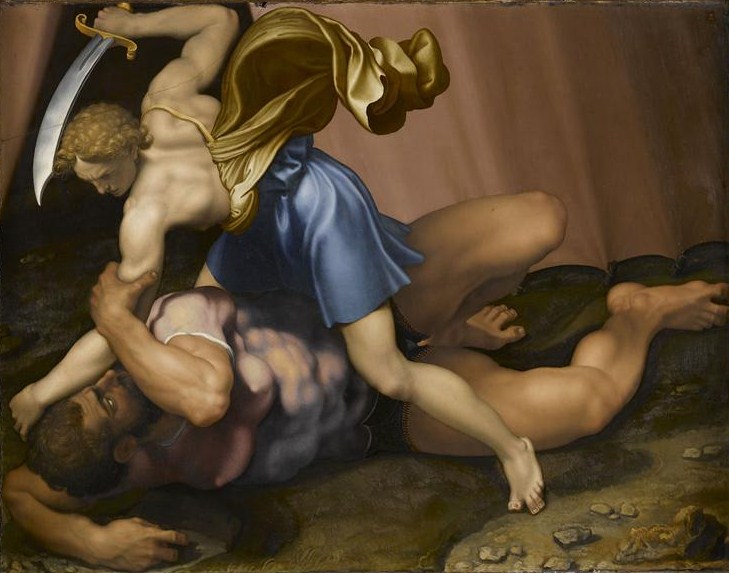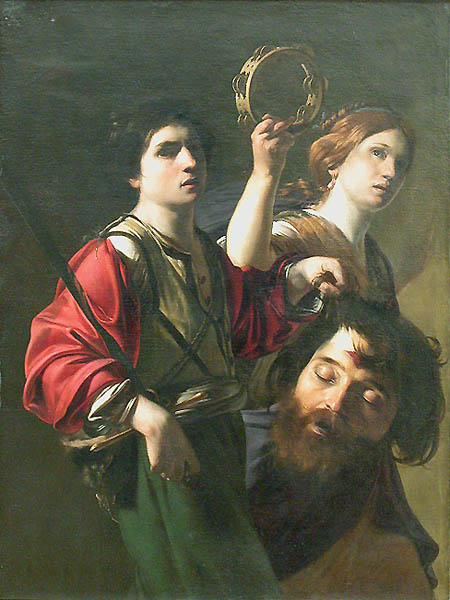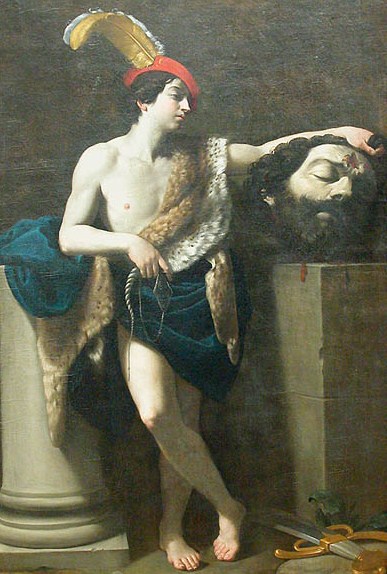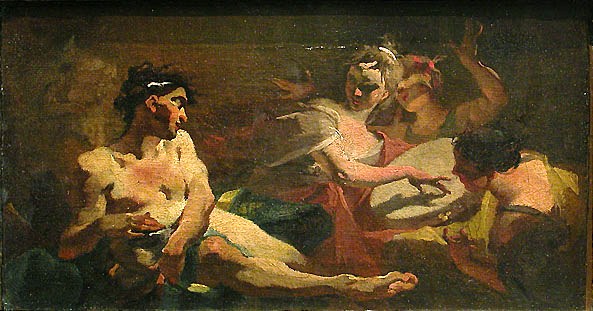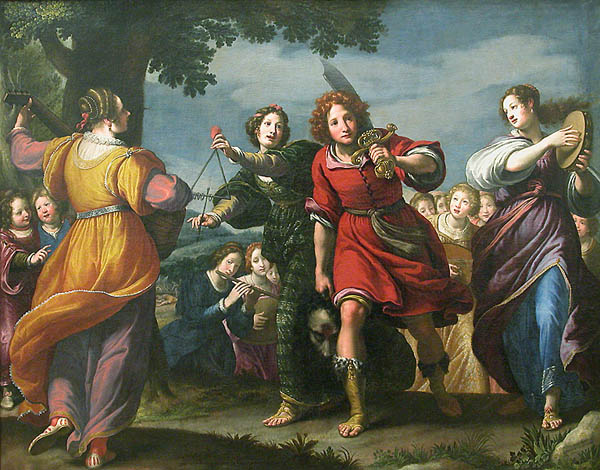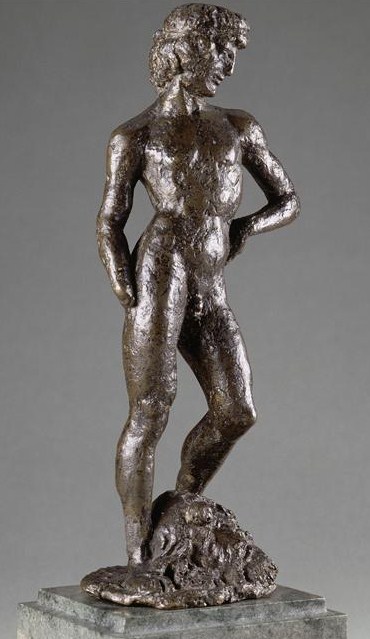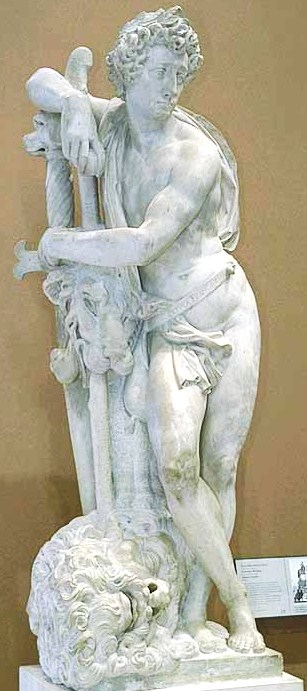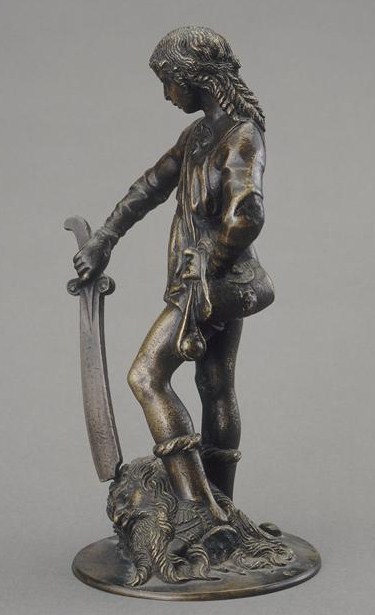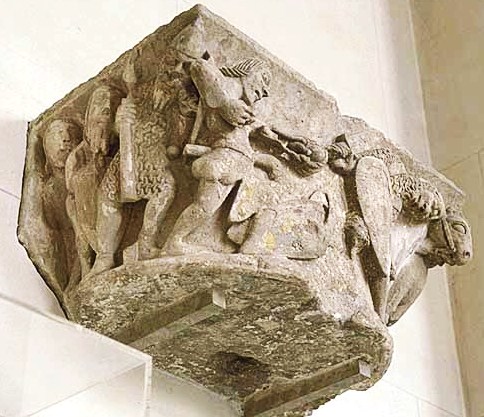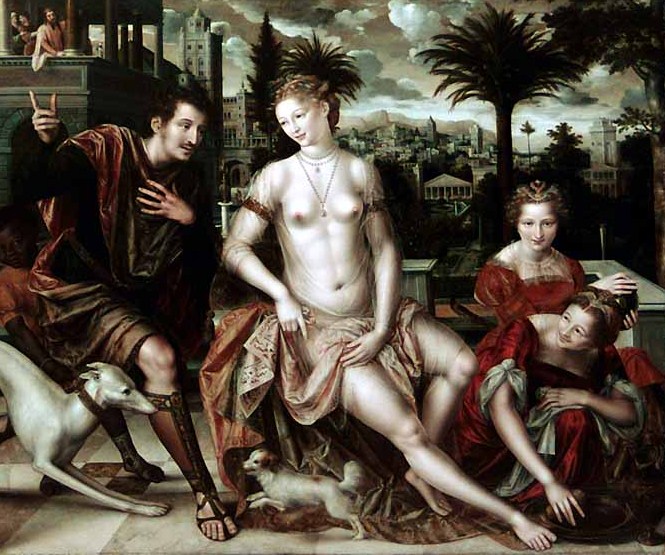Un jour, Une Œuvre,
05/04
Scenes from the story of King David in the Louvre
Many episodes of King David's life fueled the imagination of artists from all periods. The most represented are those about his fight with Goliath and his affair with Bathsheba. Courses in the halls of the Louvre and in the texts on a few scenes from the life of the king of Israel.
David anointed king by Samuel inv 4717
Claude Lorrain Claude said GELLÉE, 1647 Richelieu 2nd Lorrain Claude Lorrain said the room 15 This painting and
its counterpart,
The Landing of Cleopatra
Tarsus (1642 - 1643),
were painted for
Cardinal Angelo Giori.
About it evokes the destiny
of a humble boy became king.
" Finally Samuel said to Jes′se: “Are these all of your boys?” To this he said: “The youngest has been left out until now; he is pasturing the sheep.” Then Samuel said to Jes′se: “Send for him, because we will not sit down for the meal until he comes here.” So he sent for him and brought him in. Now he was ruddy, with beautiful eyes, and handsome in appearance. Then Jhvh said: “Get up, anoint him, for this is the one!” So Samuel took the horn of oil and anointed him in the presence of his brothers. And the spirit of Jhvh began to empower David from that day forward. Samuel later rose and went his way to Ra′mah. ” – 1 Samuel 16:11-13
Jesse RF 1344
Fragment
of representation
of a Tree of Jesse
Walnut, Netherlands,
early sixteenth century Denon Entresol
Late Gothic
Room C
"When Jesus began his work,
he was about 30 years old, being the son, as the opinion was,
of Joseph, son of He′li, (…)son of David, son of Jes′se.”
- Luke 3:23, 31,32
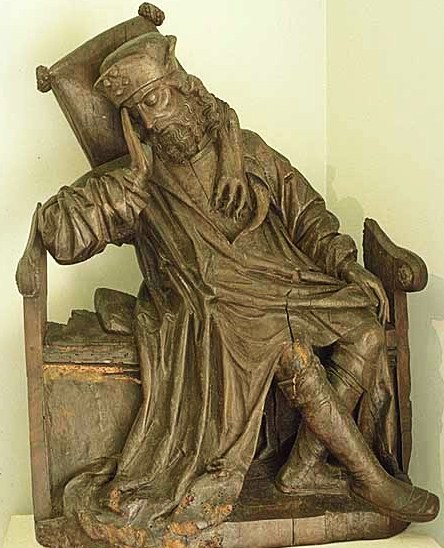
Chest of Jesse, the father of King David, asleep on his throne flows the family tree of Christ. In this type of representation, the branches of the tree were the ancestors of Christ and the summit appeared the Virgin and Child.
“ When David and the others would return from striking down the Phi·lis′tines, the women would come out from all the cities of Israel with song and dances to meet King Saul with tambourines, with rejoicing, and with lutes. The women who were celebrating would sing:“Saul has struck down his thousands,And David his tens of thousands.” Saul became very angry, and this song displeased him, for he said: “They have credited David with tens of thousands, but to me they have credited thousands. The only thing left to give him is the kingship!”. From that day on, Saul was always looking at David suspiciously. ” - 1 Samuel 18: 6-9
History of David (four episodes) inv 1033 Hans Sebald Beham, 1534
Richelieu 2nd Germanic Country fifteenth Room 7 One of the few examples of painted table top, kept in exceptional condition. Painted for Cardinal Albert of Brandenburg, archbishop of Mainz and Elector of the Holy Roman Empire. 1 - The women go out from Jerusalem to meet Saul and David. 2 - Bathsheba Bathing, coveted by David (with the portrait of Cardinal Albert Brandenburg right). 3 - Uriah, the husband of Bathsheba, the siege of Rabbath which sent David (to lose). 4 - The prophet Nathan accuses David his fault (with the portrait of the artist left ).
“ And the Phi·lis′tines assembled their armies for war. They assembled at So′coh, which belongs to Judah, and they camped between So′coh and A·ze′kah, in E′phes-dam′mim. Saul and the men of Israel assembled and camped in the Valley of E′lah, and they drew up in battle formation to meet the Phi·lis′tines. The Phi·lis′tines occupied the mountain on one side, and the Israelites occupied the mountain on the other side, with the valley between them. Then a champion came out from the camps of the Phi·lis′tines; his name was Go·li′ath, from Gath, and his height was six cubits and a span. He had a helmet of copper on his head, and he was wearing a coat of mail of overlapping scales. The weight of the copper coat of mail was 5,000 shekels. He had shin guards of copper on his legs and a javelin of copper slung between his shoulders. The wooden shaft of his spear was like the beam of loom workers, and the iron blade of his spear weighed 600 shekels; and his shield-bearer was marching ahead of him. Then he stood and called out to the battle line of Israel and said to them: “Why have you come out to draw up in battle formation? Am I not the Phi·lis′tine, and are you not the servants of Saul? Choose a man for yourselves, and let him come down to me. If he is able to fight with me and strike me down, we will then become your servants. But if I prevail against him and strike him down, you will become our servants and serve us.” The Phi·lis′tine then said: “I do taunt the battle line of Israel this day. Give me a man, and let us fight it out! ” - 1 Samuel 17: 1-10
Battle of David and Goliath
The David and Goliath battle inv 566 Oil on slate
Denon 1st Grand Hall Room 8
Daniele da Volterra realized to Giovanni della Casa for 1550-1555,
Florentine scholar who wrote a treatise on painting, a clay model
this painting on slate with two sides representing both
the battle of David and Goliath (I Kings 17, 48-51). Comparison of the two
work was to understand the merits of sculpture
and painting, a major theme of artistic theory of the sixteenth century.
The work was presented to Louis XIV in 1715 by Nicolò del Giudice,
cleric of the Apostolic Chamber, with a new gilded wooden pedestal
for rotating the paint. ww.louvre.fr
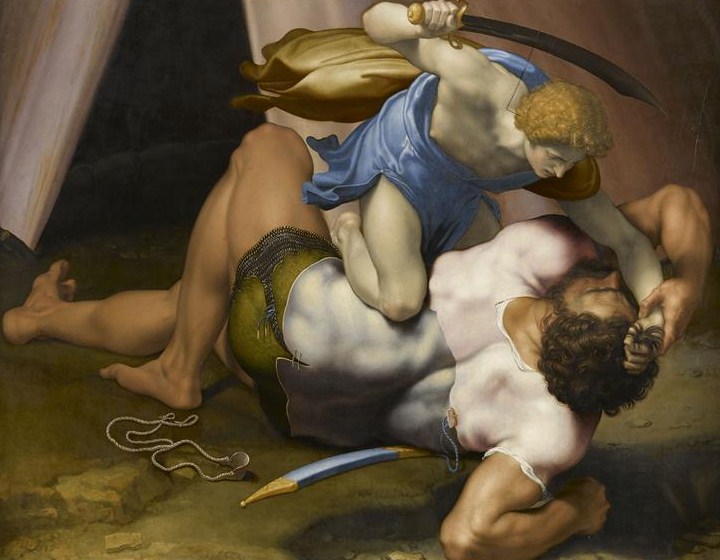
“ The Phi·lis′tine came closer and closer to David, and his shield-bearer was ahead of him. When the Phi·lis′tine looked and saw David, he sneered at him in contempt because he was just a ruddy and handsome boy. So the Phi·lis′tine said to David: “Am I a dog, so that you are coming against me with sticks?” With that the Phi·lis′tine cursed David by his gods. The Phi·lis′tine said to David: “Just come to me, and I will give your flesh to the birds of the heavens and to the beasts of the field. ” - 1 Samuel 17: 41-44
The Triumph of David
RF 1990-1929
Bartolomeo MANFREDI,
Towards 1615 Denon Grand Hall Room 8 Taken from the biblical story
the First Book of Samuel (18: 6-7):
the subject shows the triumph of David
after his victory over the giant Goliath.
Accompanied by a musician
which celebrates the waving a sistrum,
he returned triumphantly to Jerusalem.
David winner of Goliath
inv 519
Guido RENI,
Towards 1604 - 1606 Denon 1st Grand Hall Room 8 Maybe mentioned since 1619
by Cavalier Marin (Giambattista
Marino) in the Galleria,
This was probably David
was brought to France by Marshal
Charles I Crequy
whose estate inventory (1638)
mentions such a table.
“ David replied to the Phi·lis′tine: “You are coming against me with sword and spear and javelin, but I am coming against you in the name of Jhvh of armies, the God of the battle line of Israel, whom you have taunted. This very day Jhvh will surrender you into my hand, and I will strike you down and cut off your head; and on this day I will give the corpses of the camp of the Phi·lis′tines to the birds of the heavens and to the wild beasts of the earth; and people of all the earth will know that there is a God in Israel. And all those gathered here will know that it is not with the sword or the spear that Jhvh saves, for the battle belongs to Jhvh, and he will give all of you into our hand. ”- 1 Samuel 17: 45-47
The triumph of King David
The Triumph of David RF 1983-1969
Giovanni Battista TIEPOLO, Towards 1716 Denon Tiepolo room 25
Probably a sketch for a lost or not carried decor.
Prefiguring Christ's entry into Jerusalem before the Passion,
the subject is shot the biblical story of the First Book of Samuel (18: 6-7):
David, the shepherd boy will become the second king of Israel,
is celebrated by a musician playing the tambourine.
The Triumph of David inv 592
Matteo ROSSELLI, 1630 Denon 1 Salavator Rosa Room 13 The biblical subject shows
the triumph David after his victory
over the giant Goliath and
the musicians celebrating him before
he triumphantly returned to Jerusalem.
A for over a Triumph of Judith
Francesco Curradi (1570 - 1661) (Toulouse, Musée des Augustins).
“ Then the Phi·lis′tine rose and drew steadily closer to meet David, but David ran quickly toward the battle line to meet the Phi·lis′tine. David thrust his hand into his bag and took a stone from there and slung it. He struck the Phi·lis′tine in the forehead, and the stone sank into his forehead and he fell facedown on the ground. So David prevailed over the Phi·lis′tine with a sling and a stone; he struck down the Phi·lis′tine and put him to death, though there was no sword in David’s hand. ” - 1 Samuel 17: 48-51
David winner of Goliath
OA 9113 Attribué à G. RUSTICI Vers 1515 Bronze, patine noire NVA
David winner of Goliath
MR 1580 Pierre FRANCQUEVILLE, Cambrai, 1548 - Paris, 1615 Richelieu RdC salle 16
David winner of Goliath TH 60 Severo da RAVENNA
Richelieu 1er Riccio salle 12 vit 4
<
David & Goliath Battle RF 1849
milieu du XIIe siècle Richelieu RdC Cluny salle 2
>
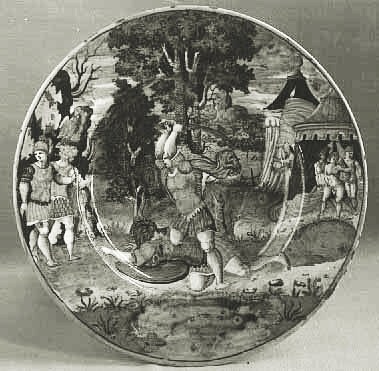
Assiette : David et Goliath
OA 1713 Attribué à Francesco DURANTINO, 1543 Faïence Richelieu 1er salle 19
<
Comb: King David sending
a messenger to Bathsheba
OA 143 Nord de la France, première
moitié du XVIe siècle, Ivoire
>
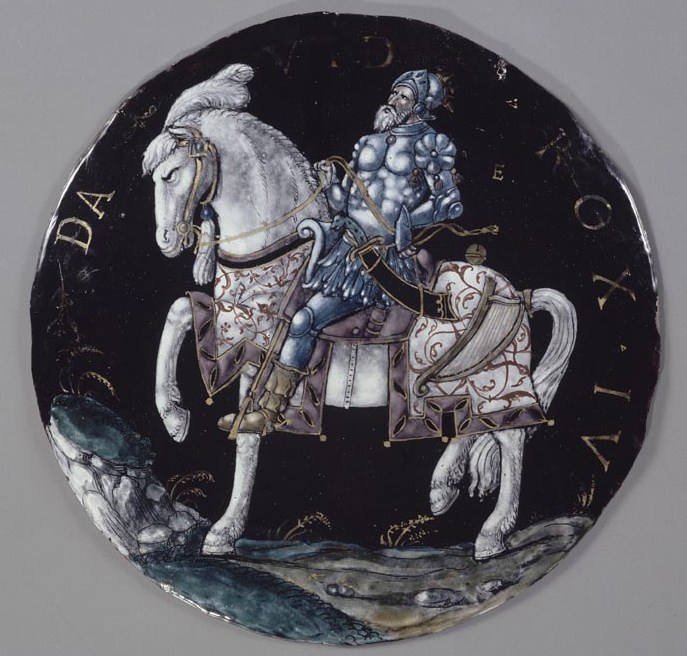
Médaillon : Le Roi David,
un des neuf preux MR 2527 Colin NOUAILHER XVIe siècle Limoges Émail peint sur cuivre Richelieu 1er salle 15 vit 3
“ One evening David got up from his bed and walked around on the rooftop of the king’s house. From the rooftop he saw a woman bathing, and the woman was very beautiful. David sent someone to inquire about the woman, and he reported: “Is this not Bath-she′ba the daughter of E·li′am and the wife of U·ri′ah the Hit′tite?” Then David sent messengers to bring her. So she came in to him, and he lay down with her. (This happened while she was purifying herself from her uncleanness.) Afterward, she returned to her house. " - 2 Samuel 11: 2-4
Bathsheba receiving David's letter RF 1349
Willem Drost, 1654
Richelieu 2nd Rembrandt Room 31
One of the latest works
the Dutch period too short
of the artist. While the narrative
effect this biblical episode is based
on the letter by which King David
invites Bathsheba to deceive
her husband Uriah General David's army. Table limited to a figure that must
be understood as a (powerful)
nude study the way Rembrandt,
albeit in a completely different mind, the incomparable Bathsheba Rembrandt painted the same year.
“ The woman became pregnant, and she sent a message to David: “I am pregnant.” At this David sent a message to Jo′ab: “Send to me U·ri′ah the Hit′tite.” So Jo′ab sent U·ri′ah to David. When U·ri′ah came to him, David asked him how Jo′ab was getting along, how the troops were getting along, and how the war was going. David then said to U·ri′ah: “Go down to your house and relax.” When U·ri′ah left the king’s house, the king’s courtesy gift was sent after him. However, U·ri′ah slept at the entrance of the king’s house with all the other servants of his lord, and he did not go down to his own house. ” - 2 Samuel 11: 5-9
David and Bathsheba inv 1446
January MASSYS son of Quentin Massys
Antwerp around 1562 Richelieu 2nd Netherlands Room 11
King David, to a terrace of his palace, look Bathsheba, wife of Uriah, he covets, and sends a servant to fetch.
Perfect demonstration of modern
how "Italian", immaculately
smooth and glossy, almost irritating,
own the son of Quentin Massys.
“ When U·ri′ah’s wife heard that her husband U·ri′ah had died, she began to mourn her husband. As soon as the mourning period was over, David sent for her and brought her to his house, and she became his wife and bore him a son. But what David had done was very displeasing to Jhvh. ” - 2 Samuel 11: 26,27
